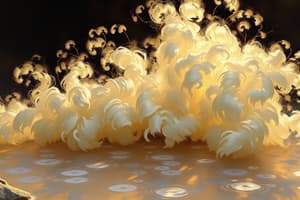Podcast
Questions and Answers
What is a key characteristic of molecules that are likely to form mesophases?
What is a key characteristic of molecules that are likely to form mesophases?
- They are typically inorganic.
- They have a spherical shape.
- They are elongated in shape. (correct)
- They possess weak dipoles.
Which property is NOT typically associated with molecules that form mesophases?
Which property is NOT typically associated with molecules that form mesophases?
- Rigid structure.
- Being organic.
- Having strong dipoles.
- Possessing highly silicate characteristics. (correct)
Which of the following traits would most likely indicate a molecule's propensity to form a mesophase?
Which of the following traits would most likely indicate a molecule's propensity to form a mesophase?
- Presence of non-polar groups.
- High molecular weight without polarity.
- No presence of strong dipoles.
- Elongated and rigid structure. (correct)
What type of molecular interaction is favored for mesophase formation?
What type of molecular interaction is favored for mesophase formation?
In the context of mesophase formation, which of the following statements is true?
In the context of mesophase formation, which of the following statements is true?
What occurs to the latent heat of vaporization when a liquid vaporizes?
What occurs to the latent heat of vaporization when a liquid vaporizes?
During which process is latent heat of vaporization liberated?
During which process is latent heat of vaporization liberated?
Which statement best describes the behavior of latent heat of vaporization?
Which statement best describes the behavior of latent heat of vaporization?
What is the primary role of latent heat during the phase change of vaporization?
What is the primary role of latent heat during the phase change of vaporization?
Which of the following best defines latent heat in the context of phase changes?
Which of the following best defines latent heat in the context of phase changes?
What is one of the assumptions made by the kinetic molecular theory of gases regarding gas particles?
What is one of the assumptions made by the kinetic molecular theory of gases regarding gas particles?
Which statement best reflects a misconception about real gases based on the kinetic molecular theory?
Which statement best reflects a misconception about real gases based on the kinetic molecular theory?
What does the kinetic molecular theory imply about the distances between gas particles in real gases?
What does the kinetic molecular theory imply about the distances between gas particles in real gases?
Why is the assumption of large distances between gas particles important in the context of real gases?
Why is the assumption of large distances between gas particles important in the context of real gases?
How does the assumption of large distances between gas particles relate to deviations in real gases from ideal gas behavior?
How does the assumption of large distances between gas particles relate to deviations in real gases from ideal gas behavior?
What is the latent heat of fusion for water at 0° C in calories per gram?
What is the latent heat of fusion for water at 0° C in calories per gram?
According to Le Chatelier's principle, how does a system at equilibrium respond to external stress?
According to Le Chatelier's principle, how does a system at equilibrium respond to external stress?
What does the term 'latent heat of fusion' specifically refer to?
What does the term 'latent heat of fusion' specifically refer to?
If a system is experiencing a change in temperature while at equilibrium, what does Le Chatelier's principle imply?
If a system is experiencing a change in temperature while at equilibrium, what does Le Chatelier's principle imply?
What is the latent heat of fusion in cal/mole for water at 0° C?
What is the latent heat of fusion in cal/mole for water at 0° C?
What do the three lines joining the corner points of the triangle represent?
What do the three lines joining the corner points of the triangle represent?
What does the area within the triangle represent?
What does the area within the triangle represent?
Which statement about the combinations of A, B, and C is true?
Which statement about the combinations of A, B, and C is true?
In the context of the triangle representing mixtures of A, B, and C, which aspect is NOT represented by the area within the triangle?
In the context of the triangle representing mixtures of A, B, and C, which aspect is NOT represented by the area within the triangle?
Which feature distinguishes the combinations of A, B, and C across the triangle's area?
Which feature distinguishes the combinations of A, B, and C across the triangle's area?
Flashcards are hidden until you start studying
Study Notes
Real Gases
- Real gases deviate from ideal gas behavior due to intermolecular forces and finite molecular volume.
- Real gases are more compressible than ideal gases because attractive forces between the molecules cause them to occupy less volume.
Latent Heats
- Latent heat of vaporization is the amount of heat absorbed when a liquid vaporizes or released when a vapor condenses.
- Latent heat of fusion is the amount of heat absorbed when a solid melts or released when a liquid freezes.
- For water at 0°C, the latent heat of fusion is approximately 80 calories per gram (1436 calories per mole).
Le Chatelier's Principle
- Le Chatelier's principle states that when a system at equilibrium is subjected to a change in conditions, it will readjust to minimize the effect of the change.
- This principle can be applied to explain the behavior of real gases.
Mesophases
- Mesophases are intermediate states of matter between solids and liquids, with properties of both.
- Molecules that form mesophases typically have these characteristics:
- Organic
- Elongated shape
- Rigid structure
- Possess strong dipoles and are easily polarizable.
Three-Component Systems
- In a three-component system, the composition can be represented by a triangular phase diagram.
- Each corner of the triangle represents a pure component (A, B, or C).
- The lines joining the corners represent two-component mixtures.
- The area inside the triangle represents all possible combinations of the three components.
Studying That Suits You
Use AI to generate personalized quizzes and flashcards to suit your learning preferences.




